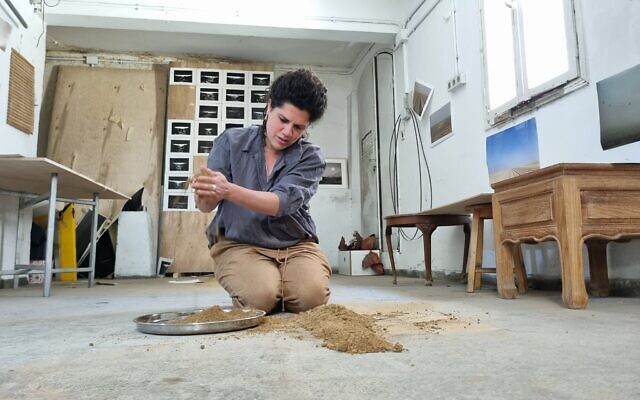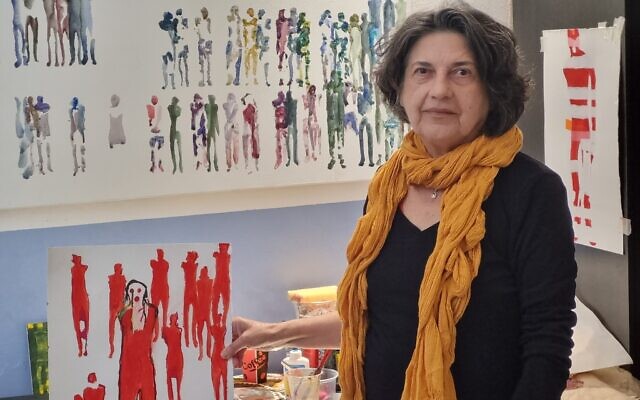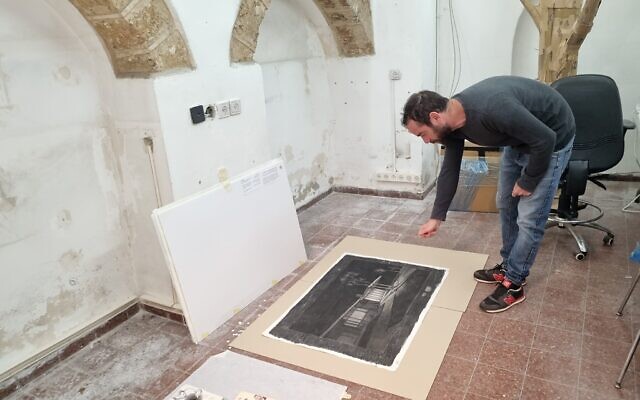Israeli artist Anuar Jour found it difficult to paint after the onset of the Israel-Hamas war on October 7.
Jour, 31, was one of approximately 200,000 Israelis evacuated from communities bordering on either Gaza or Lebanon as a result of the war that broke out after thousands of Hamas-led terrorists unleashed a massacre on southern Israel, murdering 1,200 people and kidnapping 253 more to the Gaza Strip amid unspeakable atrocities.
“I felt guilty about doing art while so many people were in such great distress,” Jour said.
In January, Jour and nine other evacuee artists were selected to participate in a three-month program offered by the Old Jaffa Artists Residency. The artists were provided with living quarters and studio space in a scenic arched building by the Jaffa seashore. In the company of fellow artists who also were grappling to express themselves, Jour once again began to create.
When The Times of Israel visited them nearly three months later, the 10 artists’ work reflected efforts to express feelings connected to the war, as well as attempts to escape from them. Some of the artists also examined notions, such as comparisons between the Holocaust and the current situation, that might be considered taboo in other settings.
Zehava Masser, Ashkelon
Zehava Masser, a daughter of Holocaust survivors, was in her Ashkelon home when her adjacent studio took a direct hit from a missile that destroyed everything in it. Somewhat presciently, she had long before written on her website, “Beauty Cannot Protect Us.” Her intention at the time, she said, was to suggest that beneath her highly aesthetic works lay many disturbing themes.
Masser’s current paintings repeat a style that she mastered in her Holocaust-themed artwork. Abstract human bodies appear in attractive colors, yet are emaciated and disfigured in form. When asked if it is possible to compare then and now, she said it would be wrong to do so in any political discussion.
“Intellectually, rationally and psychologically there is no room for comparisons,“ she said. “But our emotions speak differently.”
Tali Riaboy, Ma’alot-Tarshiha
The subject of the Holocaust also feeds into visual art created by Tali Riaboy. A resident of the northern city of Ma’alot-Tarshiha, she and her soldier sister Maya came to celebrate their grandmother Ludmilla’s birthday with her during the second week of October. Octogenarian Ludmilla endured World War II as a young child in Ukraine fleeing the Nazis with her parents.
While Tali and Maya were at their grandmother’s home, there were several rocket attacks accompanied by an alert about a suspected terrorist infiltration from the nearby Lebanese border.
“When we came out of the bomb shelter there were soldiers everywhere with their hands on the triggers of their weapons. At that moment, Grandma turned to us and said, ‘I don’t want to have that fear again,’” recalled Riaboy.
The “fear” she was referring to, explained Riaboy, were memories of her early childhood.
To calm their grandmother, Riaboy and her sister went ahead with what they have been doing ritually on their grandmother’s birthday for years: they cut her hair. Photos taken by Riaboy capture that moment and are now part of a triptych Riaboy created called “Generations of Fear.”
Nadine Bar-Noy, Sderot
The memories of October 7 remain very strong for Sderot-based artist Nadine Bar-Noy, who witnessed on social media as Hamas terrorists drove through her hometown while she sheltered in her safety room.
“I didn’t come out for three days,” said Bar-Noy, who has tried to put that experience aside to work on a personal project.
“Before the war, I hired a building contractor to renovate my home,” said Bar-Noy, listing numerous construction deficiencies she discovered after he vanished from the scene. “There’s no question in my mind that he felt he could take advantage of a woman, that his attitude reflected a patriarchal attitude too common in Israeli society.”
In constructing a multi-media piece that she calls “No Way to Build A Home,” Bar-Noy incorporated elements that reflect another painful theme.
“When I was growing up, our new immigrant family felt that we had to hide our ethnicity and not speak the Moroccan dialect in public. Only recently have I been able to return to Moroccan culture,” she said, speaking in her Jaffa residency studio, where she had a life-size drawing of her parents on one wall and a sculptured leaf based on their vineyard on another. These childhood reminders, she said, help guide her creative process.
Yaron Steinberg, Kibbutz Dafna
The theme of a home also figures prominently in the works of Yaron Steinberg, who has turned his attention to depicting the dwellings of Kibbutz Dafna, located near the Lebanese border, where he has lived for the last three years.
“It took me quite a while after October 7 before I could do anything connected to art,” said Steinberg, 41. “I asked myself what the point was of doing art. I felt completely superfluous. I’m not a doctor, I’m not even a soldier, as I was discharged from reserve duty several years ago.”
In Jaffa, Steinberg slowly began to draw his interpretation of kibbutz homes. Knowingly or not, his choice of materials, colors and technique aptly symbolized the current period.
“I realized I had to work in black and white, so I chose charcoal,” he said. “Using a process known as subtractive drawing I start by painting everything black, then slowly reveal points of light as I erase the black and bring in the white.”
Steinberg’s depictions of single-story kibbutz homes portray what he describes as “the utopian vision many kibbutzniks have of their lifestyle.” He pointed out that he uses as a frame of reference mid-20th century American architecture in the vein of Frank Lloyd Wright, with big windows providing views of nature.
Brit Einstein, Kibbutz Magen

Brit Einstein brought earth from the Kibbutz Magen potato fields to create a series of art pieces. (Bernard Dichek)
The harmony that Steinberg tries to conjure in his drawings resonates with Brit Einstein, a member of Kibbutz Magen. She reflects nostalgically about the days when she would wander barefoot through the fields of her kibbutz near the Gaza border in peaceful solitude, thinking about her art.
That idyll ended abruptly on October 7 when Einstein found herself alone in her safe room hearing gunshots and getting frantic messages from friends who had sighted terrorists. “I thought that in another five minutes my life would be over,” she recalled.
Fortunately for Einstein, the gunshots she was hearing turned out to be coming from Magen’s civilian anti-terror first responders who managed to stop the terrorists before they reached the kibbutz.
“I went to Tel Aviv afterward and didn’t do anything connected to art. Then just before joining the Jaffa residency, I felt a need to go back to the kibbutz and work on a tractor in the potato fields,” she said.
Einstein brought a barrel full of earth from the fields with her to Jaffa, where she used the soil to create a mixed-media piece. Another project she was working on is comprised of video images that could easily be interpreted as a metaphor for October 7. In the video we see waves that have created a hole in a sea wall at the Jaffa port, bursting through the opening.
As the Jaffa residency wound up at the end of March, all 10 artists had overcome their hesitations about continuing their artwork. For Jour, the turning point was a daily routine that began with volunteer work she did teaching painting to Arab and Jewish children in Jaffa.
One additional aspect of the project involved individual meetings between the artists and more than 20 art curators and gallery managers.
“Because they live in the peripheral regions of the country, it’s hard for these artists to make the connections that can advance their careers,” said Sahar Azimi, the residency manager. “That could be one silver lining for them of this troubled period.”
"artist" - Google News
May 12, 2024 at 08:56AM
https://ift.tt/fBnzRkF
Displaced by war, Israeli artists are given a seaside studio refuge following Oct. 7 - The Times of Israel
"artist" - Google News
https://ift.tt/sIcpSBL
Bagikan Berita Ini





















0 Response to "Displaced by war, Israeli artists are given a seaside studio refuge following Oct. 7 - The Times of Israel"
Post a Comment